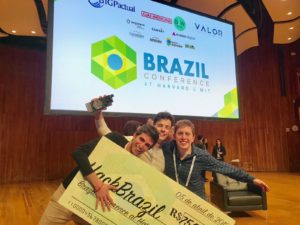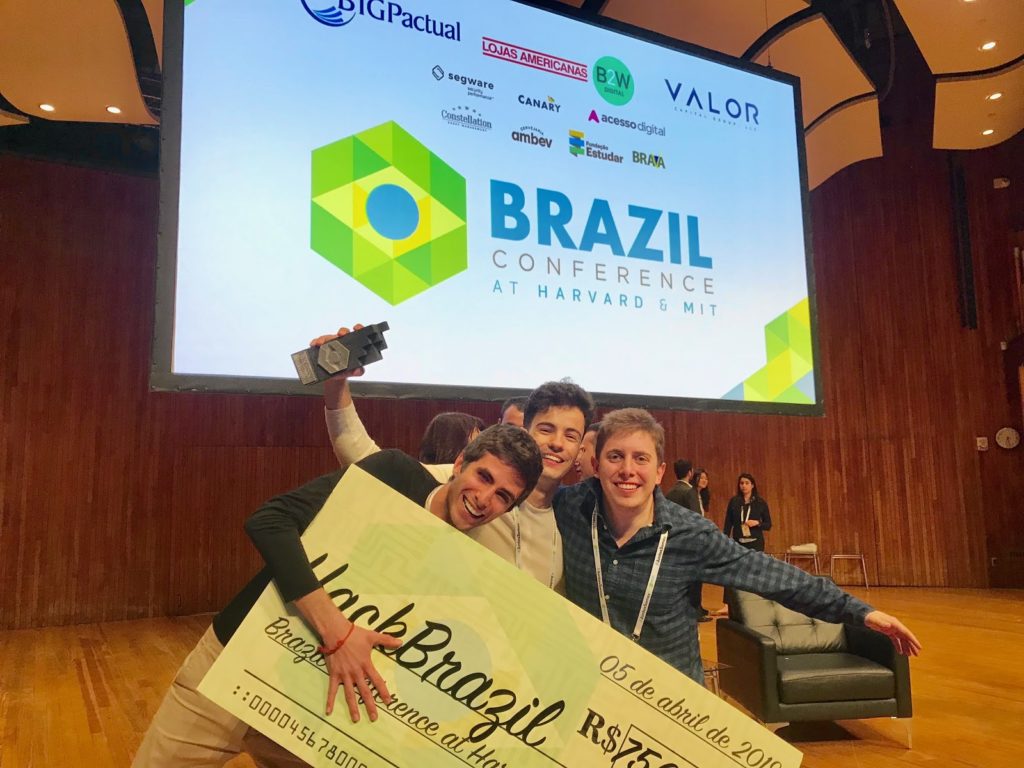For Startup Semester students from Brazil, a big win at HackBrazil was only one step in their journey to shake the healthcare industry. Their startup, Blue, integrates data and uses artificial intelligence and machine learning to predict chronic disease.
Pedro Freire, founder and CEO at Blue is a business graduate at Insper, student in MIT’s innovation course in Brazil and has experience as a health consultant. Rafael Faleck Rejtman, co-founder and head of artificial intelligence at Blue is a mechatronics engineering student at Poli-USP. Igor Marinelli, co-founder and head of technology is a computer engineering student at USP, and the founder of STH.org.br — a digital NGO in the health area to help children in need of medical treatments and surgeries in Brazil.
Their stories intertwined with their individual interests and personal experiences that drove them to improve healthcare. While Igor was focused on child healthcare with his NGO, Pedro’s grandparents were diagnosed with cancer — which was a tough time for him, and his family. Rafael lost his mother to cancer when he was 15 years old. She was treated for 6 years, and he, as a 9-year-old had been through her treatment first-hand. The trio discovered that if they were able to predict cancer before treatment begins, they’d be able to save — or at least increase the chances of saving — lives of 30% of patients. They concluded that they don’t want to spend their time on treatment, which is expensive, and instead they wanted to focus on prevention and prediction.
They noticed that there are over 50 million people with chronic diseases in Brazil. There’s an estimated R$15 billion, which is about $3.8 billion, being spent on healthcare. With their model, they can help save 30% of that expense too.
In Brazil, there’s something called a CPF — which is a unique identifier, similar to a social security number. The way Blue works, is that if someone were to input their CPF, Blue will pull data from sources like hospitals and public healthcare systems to generate a dashboard with an individual’s health data, all in real-time. The dashboard displays a range of metrics, including two main prediction modules: heart disease and Type II diabetes. It generates scales, which pull from different indicators to predict outcomes like heart risk, diabetes risk, hereditary or genealogical risk.
They understand that prediction isn’t the hard part. But, healthcare entities have such small individual data sets, which is a bigger challenge. Their goal is to crawl all types of data and integrate them. They have access to public records, and private records from their clients, who are healthcare entities like hospitals and laboratories. They also have financial and legal information like credit scores, which help trace families. There’s nothing in hospital data that indicates whether someone is a parents or relative — but a credit score shows who dependents are, to create a genealogical tree.
“You can think of it like a data silo. Imagine you’re talking about wheat in a farm, and a silo is where the wheat is loaded into. Usually, different farms have different silos — which don’t communicate,” explained Rafael. “We focus on creating the pipeline to connect these silos so all the wheat can go to the same place. If we know that you have an x-ray in one place, and a blood test in another, and we know who your parents are, that information is only useful if you look at it all together, as a whole — not separately.”
At Berkeley, in their Data-X class with professor Ikhlaq Sidhu, they learnt really fast that creating a prediction model is essentially just three lines of code on a Jupyter notebook. They realized that they should work on a data aggregation solution instead of a prediction model. This also means that their business model can be used for anything — like to predict the health of employees in any company. They ran their first viable product at a construction company in Brazil, which went successfully.
Here, as Startup Semester students, Rafael talked about how he appreciates the professors he works with. “There’s amazing teacher student interaction,” he said. “They teach you stuff and then are happy to have a coffee, or a beer to talk more. They’re so accessible, it’s just great.” Igor, on the other hand, appreciates the environment in Berkeley, and how it isn’t all bricked and structured. “Once you have everything set up, how do you solve problems?” he questioned. “The environment in Berkeley leads you to do things.”
And what are they doing next? They definitely want to continue working on Blue. They’ve already received investment opportunities and are waiting for the right moment — the three aim to narrow down clients and move further. They want their first client to be their first investor.
“Pedro is focusing completely on Blue,” said Rafael. “It’s his baby, his life dream. He’s pushing us all the time — he’s always full of energy, every day.”
When asked about how they would balance his last year of university back in Brazil with his commitment to Blue, Igor was quick to respond.
“We’re going to work on Blue — I don’t know if university is going to work for us!”
They talked about their presentation at HackBrazil, describing how they did a live demonstration by asking a judge for their CPF number, and successfully pulling up her health data live, in front of an audience. HackBrazil at MIT and Harvard — a year-long hackathon — had 400 startups, which eventually narrowed down to 4 finalists. They discussed their experience making their final pitch, in front of a jury of judges including Instagram’s Mike Krieger, partners of large investment funds in Brazil, among others.
For Startup Semester students from Brazil, a big win at HackBrazil was only one step in their journey to shake the healthcare industry. Their startup, Blue, integrates data and uses artificial intelligence and machine learning to predict chronic disease.
Pedro Freire, founder and CEO at Blue is a business graduate at Insper, student in MIT’s innovation course in Brazil and has experience as a health consultant. Rafael Faleck Rejtman, co-founder and head of artificial intelligence at Blue is a mechatronics engineering student at Poli-USP. Igor Marinelli, co-founder and head of technology is a computer engineering student at USP, and the founder of STH.org.br — a digital NGO in the health area to help children in need of medical treatments and surgeries in Brazil.
Their stories intertwined with their individual interests and personal experiences that drove them to improve healthcare. While Igor was focused on child healthcare with his NGO, Pedro’s grandparents were diagnosed with cancer — which was a tough time for him, and his family. Rafael lost his mother to cancer when he was 15 years old. She was treated for 6 years, and he, as a 9-year-old had been through her treatment first-hand. The trio discovered that if they were able to predict cancer before treatment begins, they’d be able to save — or at least increase the chances of saving — lives of 30% of patients. They concluded that they don’t want to spend their time on treatment, which is expensive, and instead they wanted to focus on prevention and prediction.
They noticed that there are over 50 million people with chronic diseases in Brazil. There’s an estimated R$15 billion, which is about $3.8 billion, being spent on healthcare. With their model, they can help save 30% of that expense too.
In Brazil, there’s something called a CPF — which is a unique identifier, similar to a social security number. The way Blue works, is that if someone were to input their CPF, Blue will pull data from sources like hospitals and public healthcare systems to generate a dashboard with an individual’s health data, all in real-time. The dashboard displays a range of metrics, including two main prediction modules: heart disease and Type II diabetes. It generates scales, which pull from different indicators to predict outcomes like heart risk, diabetes risk, hereditary or genealogical risk.
They understand that prediction isn’t the hard part. But, healthcare entities have such small individual data sets, which is a bigger challenge. Their goal is to crawl all types of data and integrate them. They have access to public records, and private records from their clients, who are healthcare entities like hospitals and laboratories. They also have financial and legal information like credit scores, which help trace families. There’s nothing in hospital data that indicates whether someone is a parents or relative — but a credit score shows who dependents are, to create a genealogical tree.
“You can think of it like a data silo. Imagine you’re talking about wheat in a farm, and a silo is where the wheat is loaded into. Usually, different farms have different silos — which don’t communicate,” explained Rafael. “We focus on creating the pipeline to connect these silos so all the wheat can go to the same place. If we know that you have an x-ray in one place, and a blood test in another, and we know who your parents are, that information is only useful if you look at it all together, as a whole — not separately.”
At Berkeley, in their Data-X class with professor Ikhlaq Sidhu, they learnt really fast that creating a prediction model is essentially just three lines of code on a Jupyter notebook. They realized that they should work on a data aggregation solution instead of a prediction model. This also means that their business model can be used for anything — like to predict the health of employees in any company. They ran their first viable product at a construction company in Brazil, which went successfully.
Here, as Startup Semester students, Rafael talked about how he appreciates the professors he works with. “There’s amazing teacher student interaction,” he said. “They teach you stuff and then are happy to have a coffee, or a beer to talk more. They’re so accessible, it’s just great.” Igor, on the other hand, appreciates the environment in Berkeley, and how it isn’t all bricked and structured. “Once you have everything set up, how do you solve problems?” he questioned. “The environment in Berkeley leads you to do things.”
And what are they doing next? They definitely want to continue working on Blue. They’ve already received investment opportunities and are waiting for the right moment — the three aim to narrow down clients and move further. They want their first client to be their first investor.
“Pedro is focusing completely on Blue,” said Rafael. “It’s his baby, his life dream. He’s pushing us all the time — he’s always full of energy, every day.”
When asked about how they would balance his last year of university back in Brazil with his commitment to Blue, Igor was quick to respond.
“We’re going to work on Blue — I don’t know if university is going to work for us!”
They talked about their presentation at HackBrazil, describing how they did a live demonstration by asking a judge for their CPF number, and successfully pulling up her health data live, in front of an audience. HackBrazil at MIT and Harvard — a year-long hackathon — had 400 startups, which eventually narrowed down to 4 finalists. They discussed their experience making their final pitch, in front of a jury of judges including Instagram’s Mike Krieger, partners of large investment funds in Brazil, among others.


